The Edison Series
Edison format is great because it featured a lot of different decks. It was a format where the difference in power of a Tier 3 and Tier 1 deck wouldn't make the Tier 3 deck an overwhelming underdog. I hope that through reading this, you're encouraged to check out some of the other Edison articles I've written and get into the format.
Note: Deck Introductions are NOT a super in-depth guide of a deck. Many decks during Edison format have numerous interactions and matchup specifics.
Prologue
Quickdraw Plants is one of the new decks that emerged during Edison Format. This deck is one of the earliest iterations of Plant Synchro and generates threats through small combos. Most of the deck's plays revolved around Dandylion. This deck was strong because it was flexible in being able to attack from multiple angles. In this article, we'll review some basics of the deck and its strategies.
The Road to Edison
The Quiet Before the Storm
Quickdraw Plants was a new and up-and-coming deck going into Edison. It had many variants that incorporates small changes to adjust to the user's playstyle. The deck was different as it was a non-archetype deck entering a new meta which was previously dominated by archetype-style decks. Despite this, many players represented the deck at Edison including some previous SJC Champions.
A Jumble of Chaos
Quickdraw Plants was a powerful deck because of its wide range of options. Although the game-plan was to mill Dandylion into the GY and then gain advantages afterwards, the deck had threats everywhere. This made the deck hard to play against as they had many different opening plays which accomplished different objectives. An opening play could be as simple as setting one to each zone or turbo-ing into Tytannial with backrow. However, having a lot of options isn't always a good thing. Quickdraw Plants was also one of the hardest decks to pilot in the format and required users to consistently make the best decisions. With this much versatility, this mirror match would be considered one of the hardest mirror matches often resulting the better player coming out on top.
Champions of Edison
Quickdraw Plants would end up having 3 representatives in the Top 16 all using similar but different strategies. Sorosh Saberian (Top 4) ran Cyber Valley and Battle Fader valuing more utility and defensive options. Jerry Wang (Top 8) would be the only list out of the 3 to play 2 LADDs and Treeborn Frog along with Trap Dustshoot valuing knowledge and pressure. Jeff Jones (Champion) would be the only list to play 3 Pot of Avarice along with Card Trooper and Night Assailant with a heavier resource game. These decks, although built overall similarly, had small changes which would change the deck's operation drastically. With the deck being so difficult to pilot perfectly, It would come as no surprise that all 3 of these players were very successful in Yu-Gi-Oh throughout their competitive play.
Notable Cards of the Deck
Main Deck Monsters
Dandylion
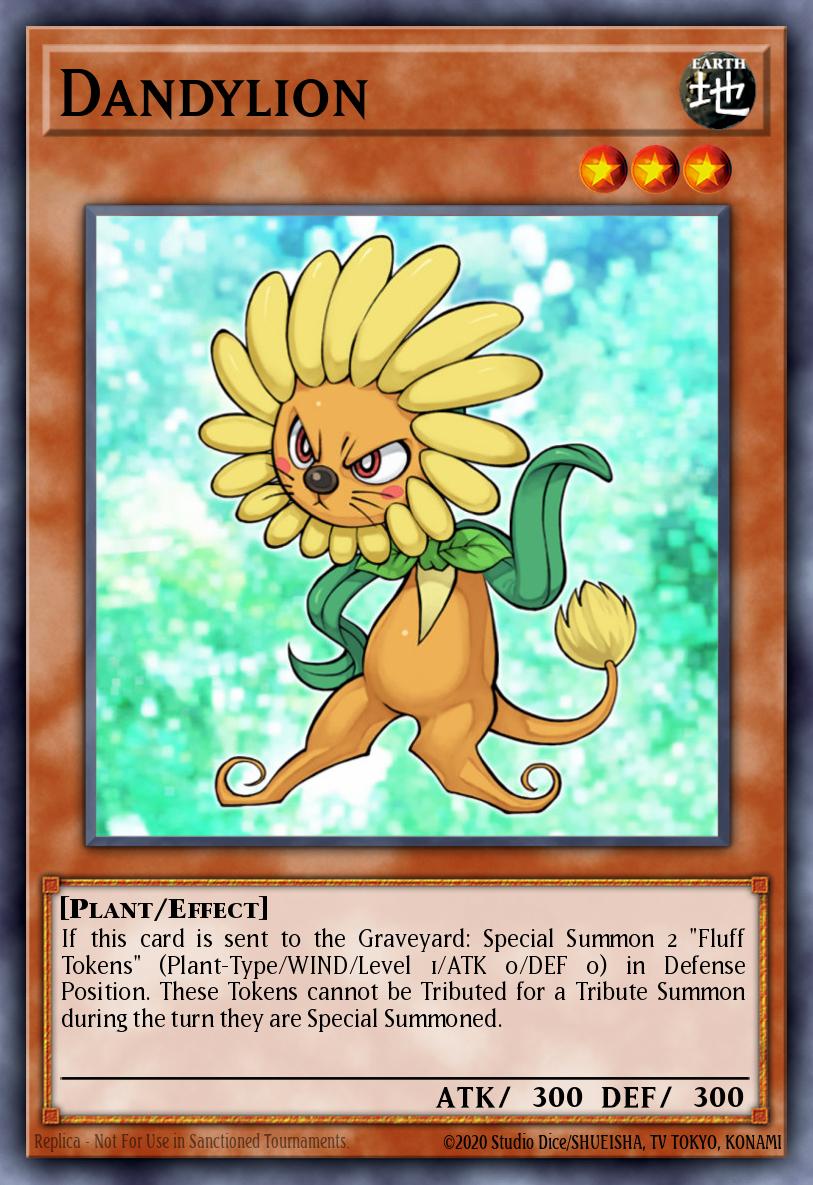
Dandylion is a Level 3 PLANT monster that generates 2 tokens if it's sent to the GY.
Many consider Dandylion to be the heart and soul of the deck. It creates multiple advantages and your play doesn't usually start until Dandylion reaches the GY. Both Dandylion and its tokens are crucial and open a variety of plays when accessible. Dandylion had numerous interactions such as:
- Using Tokens to Tribute Summon Caius or Light and Darkness Dragon
- Using Tokens for Tytannial's effect
- Synchro-ing with Debris Dragon for Black Rose Dragon and then leaving behind tokens
- Used for Drill Warrior's effect and then recycled
and many more. Giving context to everything Dandylion can do is difficult as there's just so many combos. Every list utilized Dandylion but some did it in different ways. For example, Sorosh ran Cyber Valley which could banish itself along with a Token to draw 2.
Since Dandylion was such an essential card, it also became an important target to side against. Many players opt'd to side cards that counter Dandylion such as D.D. Crow and Chain Disappearance. A game against Quickdraw Plants would often come down to how well you can prevent them from using Dandylion.
Quickdraw Synchron
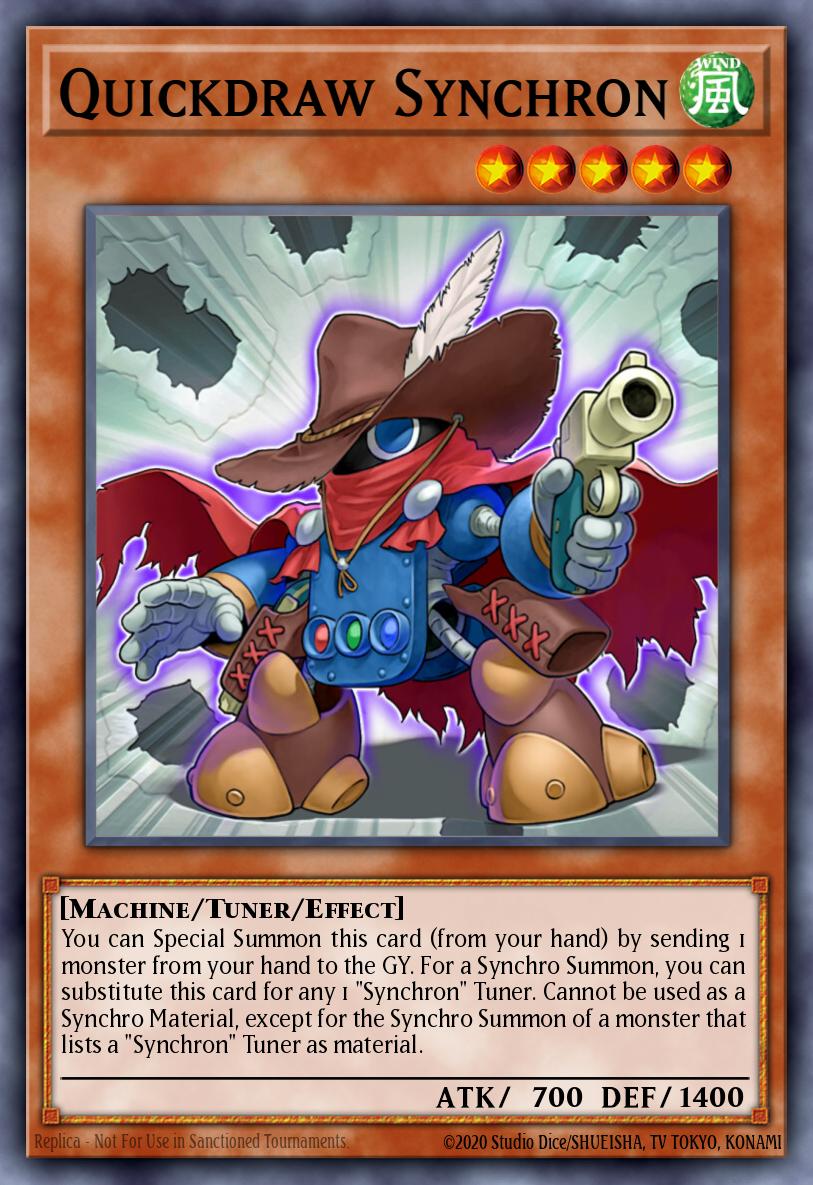
Quickdraw Synchron is a Level 5 Synchron monster that special summons itself by sending 1 monster from your hand to the GY. It also acts as a substitute for any Synchron Tuner during a Synchro Summon.
Quickdraw is most commonly used to summon Drill Warrior during Edison. It also helped discarding Dandylion from your hand without committing your normal summon/set. Quickdraw could also Synchro into Nitro Warrior or Junk Archer using Ryko as Synchro material. This is a good way to utilize a Ryko after it's flipped face-up.
Quickdraw is just another very flexible card in the deck. It could Synchro into a lot of options all for different positions. It provided power in the form of Nitro Warrior as well as removal in the form of Junk Archer. Quickdraw is also one of the few cards during this format that could special summon itself with an easy condition. This is important because special summoning was much more scarce back then compared to the modern format. Overall, Quickdraw complimented the deck's playstyle well and provided even more options to a deck that didn't lack any to begin with.
Debris Dragon
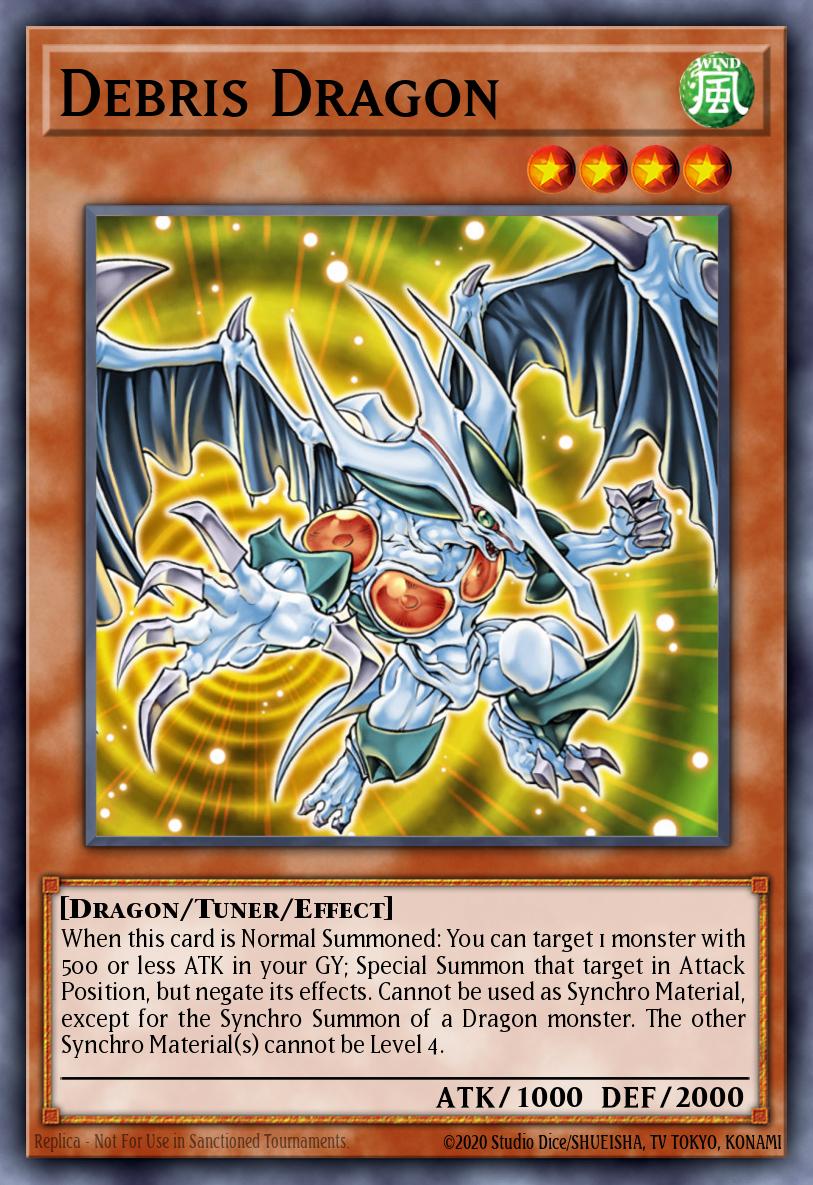
Debris Dragon is a level 4 Tuner that revives low ATK monsters from your GY. This would often result in a follow-up play usually summoning a Level 6/7/8 Dragon Synchro.
Debris is another monster that similarly to Quickdraw, was very flexible. Its most common purpose was to revive Dandylion and then Synchro into Black Rose Dragon. Summoning Black Rose was powerful as it could clear the board while leaving you with 2 tokens or deal good damage through DEF-position monsters with its 2nd effect. Debris could also Synchro into other Dragons such as Iron Chain Dragon using Ryko and Stardust Dragon using Dandylion + 1 token. Debris also had good stats as its ATK was low enough to be searched by Sangan while dodging Bottomless and its DEF was high enough to block against 1900 ATK beaters.
Overall, Debris is another card which compliments the deck; giving you lots of options for different situations. It could turn games around with a sudden Black Rose and also extend pressure with Stardust. Debris is one of the deck's best normal summons and almost always gets value when there's a Dandylion in grave.
Lonefire Blossom + Tytannial, Princess of Camellias
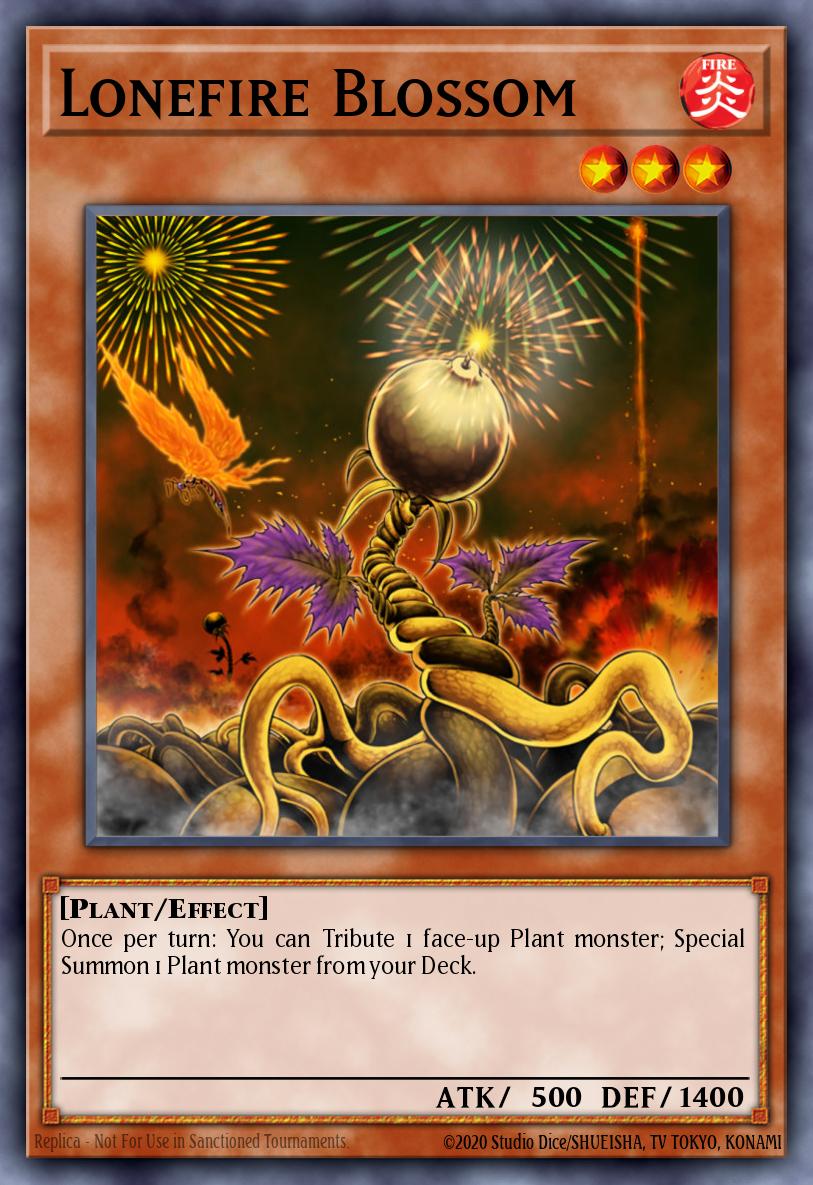
Lonefire and Tytannial was the plant package that the majority of Quickdraw Plants decks played. This was a strong package as both card worked well around each other and Dandylion.
Lonefire Blossom is a tutor that gives you access to any PLANT in your deck. It was mainly used to summon Dandylion as a quick setup or used to summon Tytannial to beat over Stardust. Lonefire can also tribute Dandy tokens for its summoning effect and is a Level 3 that can be summoned off Debris. Lonefire is a good starter as it gets you to your most important card while also giving you another option in summoning a strong boss monster.
Tytannial is a boss monster with strong stats and a solid effect. It was able to contest most popular Synchros like Stardust and Thought Ruler Archfiend while matching Goyo Guardian. Tytannial's effect was also very strong because it would often be free since you'd have leftover Dandy tokens. This made Tytannial difficult to deal with because it could popular cards like Book of Moon, Brain Control and Dimensional Prison.
Overall, both Lonefire and Tytannial were great monsters in the deck's lineup. They both had multiple interactions and could even act as one of the deck's win conditions.
Super-Nimble Mega Hamster + Ryko, Lightsworn Hunter
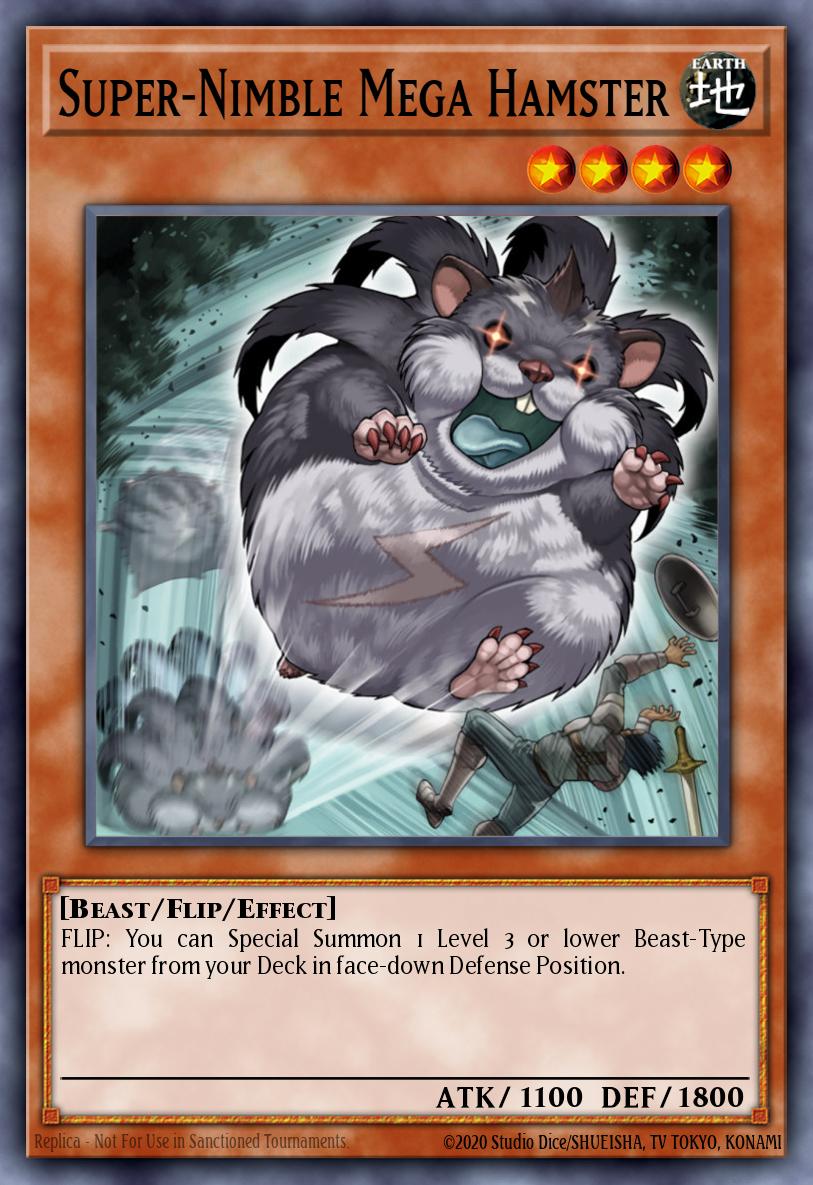
Super-Nimble and Ryko was the small FLIP package that was played in many decks throughout Edison.
Hamster's role in the deck is rather simple as its only purpose is to tutor Ryko. It was a good defensive option with 1800 DEF and often nets you an eventual +2 when it's FLIP'd.
Ryko on the other hand serves multiple purposes. It was good at simplifying the game-state by popping a card and also helped mill your deck. Ryko is also arguably one of the most popular cards in Edison format. It was incredibly flexible as it has 2 effects that both support a majority of different decks throughout the format. There is even certain interactions where Ryko can make floater effects miss timing.
Ideally, Hamster wants to be FLIP'd during the opponent's turn so you can tutor Ryko and FLIP it on your own turn. This is a good way to remove threats and then follow up with a tribute summon like Caius of LADD. Overall, the package was just good and many decks outside of Quickdraw Plants variants also played it.
Caius the Shadow Monarch + Light and Darkness Dragon
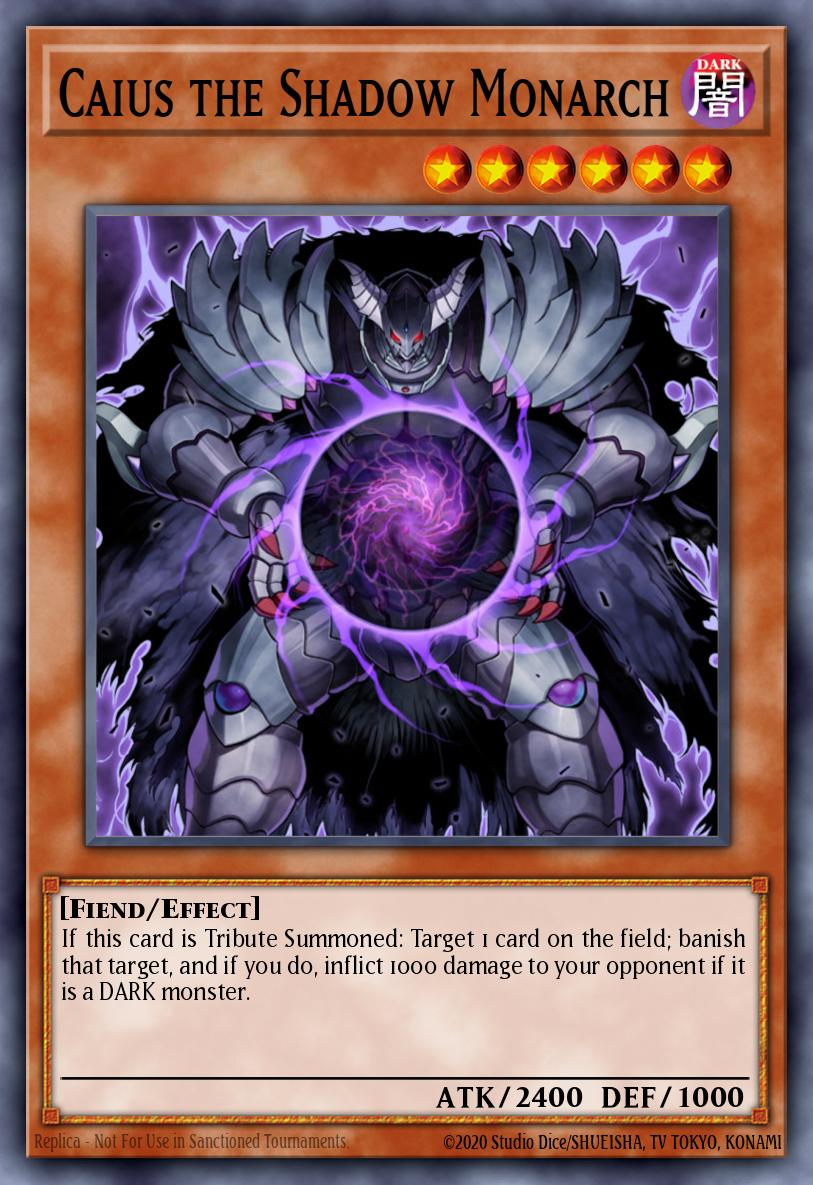
In the Quickdraw Plants deck, tribute summoning is often free and easy. Since the deck generates many tokens, it's natural to play some tribute summon threats incase you may be locked out by a Royal Oppression.
Caius the Shadow Monarch was a stronger 1 tribute monster that provided removal in the form of banishing a card. This made Caius good for removing backrow as well as problematic monsters such as Stardust Dragon. Caius also had a burn effect which sometimes came up as it let you banish itself for game when your opponent was under 1000 LP. This was also an added bonus against DARK decks such as Blackwings and strong generic DARK monsters.
Light and Darkness Dragon was an extremely impactful 2 tribute monster that could end games on its own. Packing an effect that negates the activation of cards by decreasing its own stats, it was very problematic to deal with as it'd often negate twice before being in range to be beat over. Some players would even chain Book to its effect to flip it face-down and reset its stats. When LADD is destroyed, it also leaves behind a monster which could be something powerful sleeping in your GY or a Dandylion to leave you with some defense.
Tribute monsters weren't really prominent during Edison format but had a sizable role in the Quickdraw Plants deck. Although some might view tributes as outdated, the strength of these cards really shined in Top 8 where each of the lists played either 3 Caius or at least 1 LADD.
Spells & Traps
I'll only briefly talk about this, as the S/T lineup for the deck wasn't anything too special. Most lists played the generic lineup of staples with certain cards being played more or less due to preference. Variance is mainly found in whether the deck was built more offensively/defensively. Aggressive lists would choose to play more Dust Tornado to clear backrow. Defensive lists would opt to max out on Dimensional Prison. Pot of Avarice can also be maxed or played at two based on the user's playstyle.
Extra Deck
Drill Warrior

Drill Warrior is a Level 6 Synchro that is best related to "drill looping." It was one of the more flexible Synchros in your arsenal providing chip damage, recursion and pressure.
Drill Warrior is a key component to the Edison deck and one of the reasons it performed as well as it did. It could discard a card to remove itself from the field for a turn. And it returns to the field during your next SP phase to do it all again. It even adds back a monster from your GY when it comes back. Though this might seem underwhelming, the potential to generate infinite value and constantly fix your hand is incredible.
Overall, Drill Warrior is a flexible card that can be really annoying for your opponent to deal with. One combo was to continuously add back and discard Dandylion with Drill Warrior's effect. This combo continuously provided tokens as long as you could maintain it. Being unable to stop the "drill loop" results in your opponent having a steady stream of monsters along with you steadily losing LP.
Turbo Warrior + Nitro Warrior

Turbo Warrior and Nitro Warrior are Level 6/7 Synchros that are more situational than Drill Warrior. Though not as flexible as Drill Warrior, both of these Synchros are really strong when the situation calls for it and can catch your opponent off guard.
Turbo Warrior is the Level 6 Synchro that specializes in beating over Level 6 or higher Synchro monsters. This made it very good for beating basically every meta Synchro at the time with the exception of Ally of Justice Catastor. Turbo Warrior also cannot be targeted by the effects of Level 6 or lower monsters which although niche, helps it dodge monsters like Ryko, Caius, Murmillo and GK Descendant.
Nitro Warrior is the Level 7 Synchro that is used as a damage pusher and game ender. It excels in situations where your opponent has two monsters (1 in DEF position) and could deal heavy damage in the right situation. It is especially good against Dandy tokens.
Overall, these cards along with Junk Archer fit the niche that can sometimes take games off your opponent. Although they won't be summoned every game, when they do get summoned they'll definitely shine.
Playstyle & Strategy
Early Game
In the early game, focus on setting up your GY. Standard plays include setting you FLIP monsters or summoning Lonefire into Dandylion. Different builds can also contain different openers. Cyber Valley and Card Trooper are also good openers as they offer utility and card draw.
Mid Game
In the mid game, you play off the setup you have done in the early game. There are multiple options that are relevant to each game state. In a neutral game state, Drill Warrior is a solid option. To come back on the board, Debris into Black Rose is often powerful. In advantageous positions, Stardust Dragon is a great go-to to extend pressure. Tribute summon monsters are also good here as they are usually low commit for medium-impact cards.
Late Game
Quickdraw Plants is a deck that doesn't really have any late game specialties. Most of your strong plays happen in the mid game and the late game is just a repeat of that. The good news here is that you play Pot of Avarice which makes you able to out-grind most matchups. Eventually, most late games end in you having more resources than your opponent and being able to continuously apply pressure.
Some Basic Combos and Interactions
Here are some basic combos and interactions of the deck.
- Quickdraw Synchron + Dandylion
- Special Summon Quickdraw by discarding Dandylion (generating 2 tokens)
- Synchro Quickdraw with 1 token for Drill Warrior
- Drill Warrior can banish itself from the field and star recycling Dandylion or another card - Board Wipe + 2 Tokens (Req: Debris Dragon + Dandylion in GY)
- Normal Summon Debris using effect to target Dandylion
- Synchro Summon using both to go into Black Rose
- Both Black Rose and Dandylion's effect activate with Dandylion being CL1 and Black Rose being CL2
- The field gets destroyed by Black Rose and Dandylion spawns 2 Tokens - 3 Negate Tytannial (Req: Tytannial + Dandylion)
- Tytannial tributes Dandylion for its own effect
- Dandylion spawns 2 PLANT Tokens
- Tytannial now has 2 extra effect usages due to Tokens - Super-Nimble Tribute (Req: Super-Nimble Mega Hamster + Tribute Summon Monster)
- Super-Nimble is flipped during your opponent's turn summoning Ryko
- FLIP Summon Ryko to pop a card and mill 3
- Tribute Ryko for Caius or both monsters for Light and Darkness Dragon
Quickdraw Plants is a deck that's very flexible. Builds that incorporate ideas such as Card Trooper and Cyber Valley also have interactions that are not mentioned above. For example, Cyber Valley can banish itself along with a Dandy token to draw two cards. Try and see to find out what combos and interactions you can find by making the deck your own.
Resource Management and Grinding
Knowing how to manage resources and grind in many matchups is very important during the Edison metagame. With a finite number of power plays before you run out of gas, players must carefully decide when to use certain cards to get the most out of them.
When talking about grinding, Pot of Avarice naturally comes into the picture. Avarice is strong because it recycles resources which included powerful normal summons like Debris and Limited Synchros such as Black Rose. This was troublesome to play against since it made it difficult to track how many plays the deck would still have. For example, an opponent might overcommit to the field once they see 2 Debris and a Black Rose in GY just for the Quickdraw Plants player to activate Avarice and Black Rose again. Different builds also played Avarice in different quantities. Jeff Jones's 1st place build played 3 Avarice along with Card Trooper, Morphing Jar and Night Assailant. Through this, we could see he favored a more resource-heavy grind game compared to other lists that favored other options.
Making it your own
It's important to note that due to the short time frame of Edison, it's still a format that's widely unexplored. With numerous card combinations still untouched, there's still room for improvement to make a "better" list. When building this deck, take into account how you like to play and include card choices that favor your playstyle.
Closing Thoughts
Quickdraw Plants is a deck that's difficult to explain through just a few paragraphs. It is one of the most difficult decks to pilot and has an abundance of different builds. Though this article only scratches the surface of what the deck can do, I hope it motivates you to give Edison format a try!



